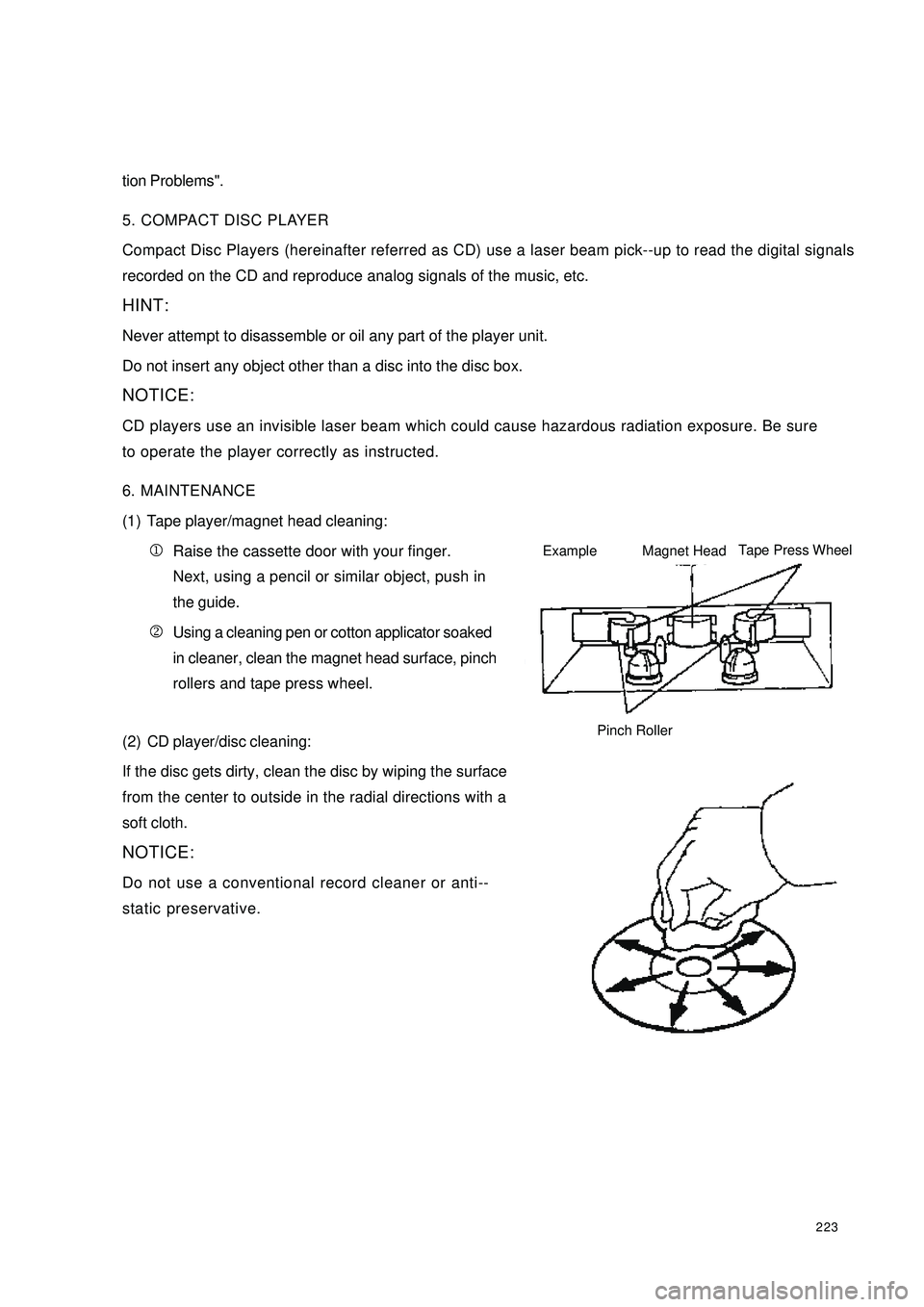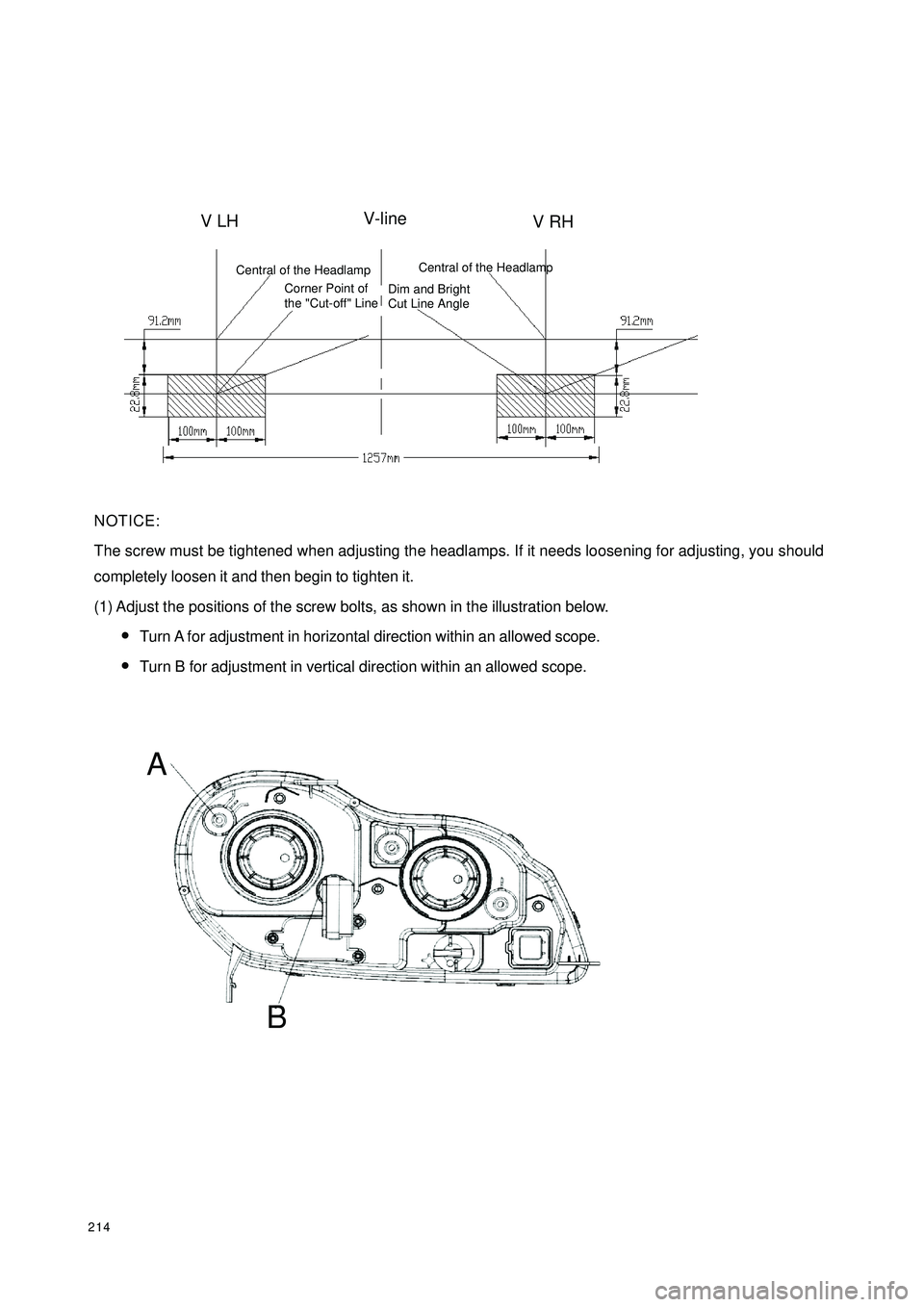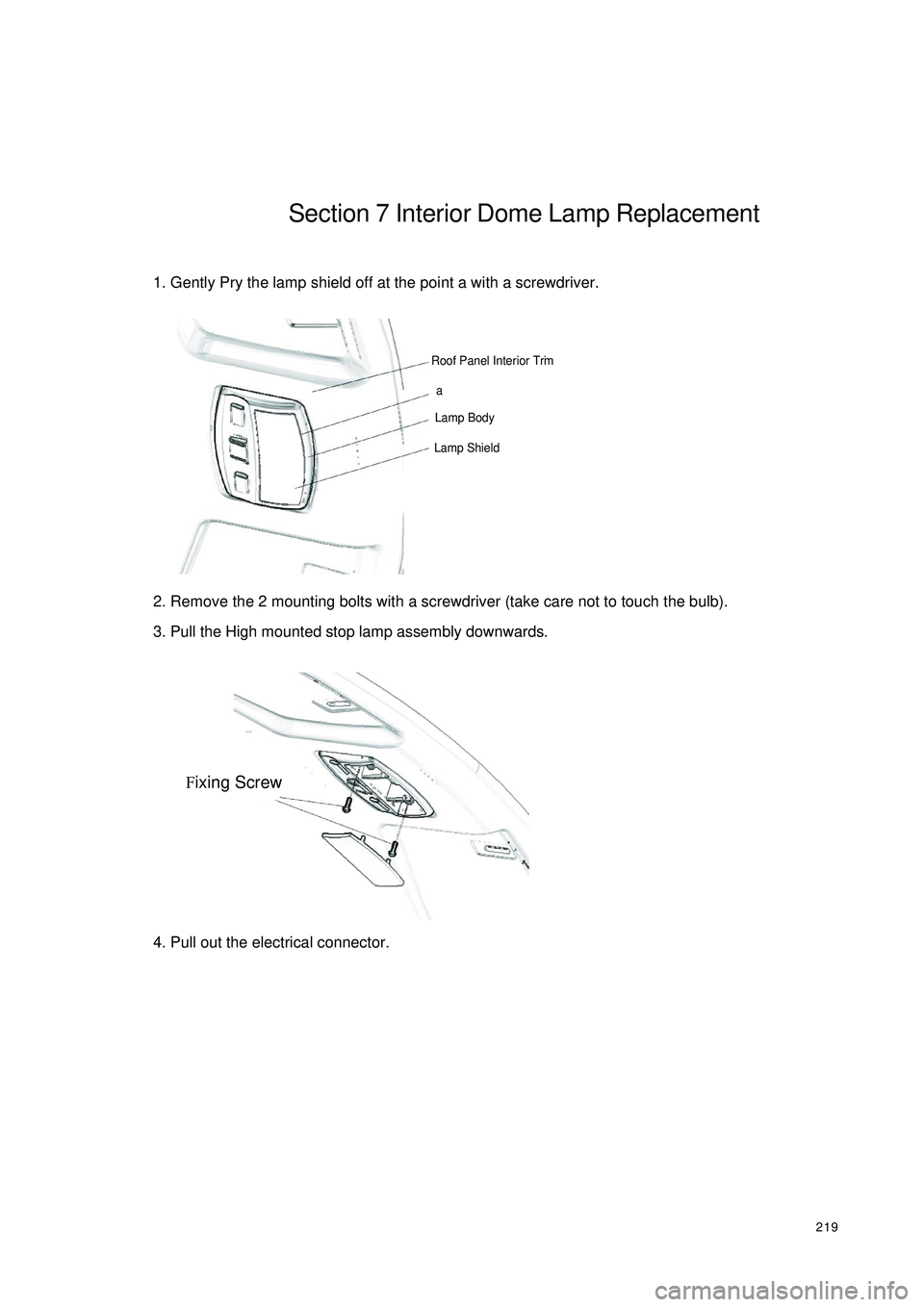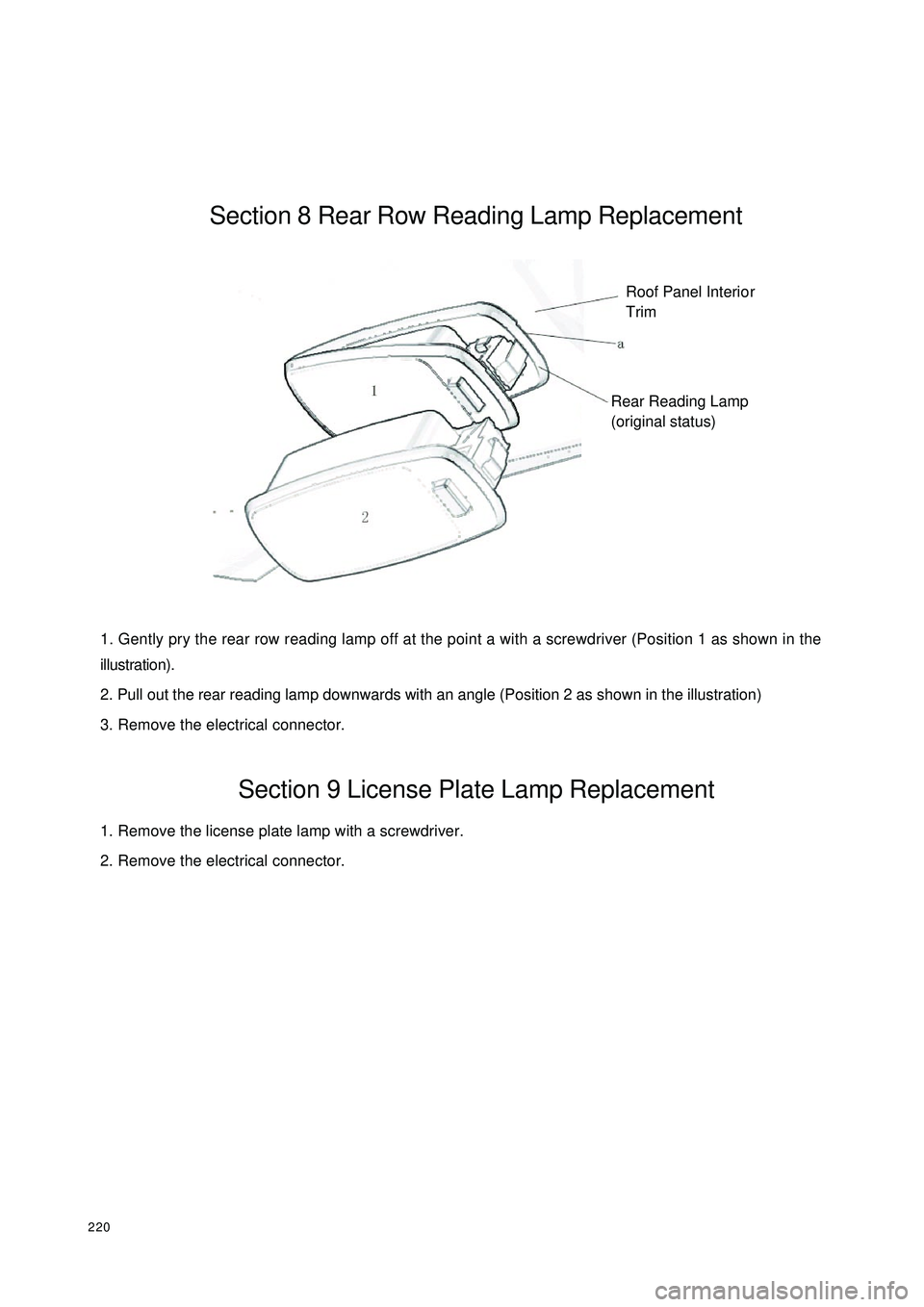GEELY CK 2008 Workshop Manual
Manufacturer: GEELY, Model Year: 2008,
Model line: CK,
Model: GEELY CK 2008
Pages: 392, PDF Size: 38.86 MB
GEELY CK 2008 Workshop Manual
CK 2008
GEELY
GEELY
https://www.carmanualsonline.info/img/58/57159/w960_57159-0.png
GEELY CK 2008 Workshop Manual
Trending: hood release, ground clearance, engine overheat, inflation pressure, power steering fluid, battery, radiator cap
Page 221 of 392
214NOTICE:
The screw must be tightened when adjusting the headlamps. If it needs loosening for adjusting, you should
completely loosen it and then begin to tighten it.
(1) Adjust the positions of the screw bolts, as shown in the illustration below.
�yTurn A for adjustment in horizontal direction within an allowed scope.
�yTurn B for adjustment in vertical direction within an allowed scope.V LHV RHV-lineCentral of the HeadlampCentral of the HeadlampCorner Point of
the "Cut-off" LineDim and Bright
Cut Line AngleA
B
Page 222 of 392
215Section 4 Front Fog Lamp ReplacementI. REMOVAL1. Remove the front bumper.(See bumper replacement)
2. Remove the electrical connector.
3. Remove the mounting bolts (A, B as shown in the illustration).
4. Remove the front fog lamp assembly.II. INSTALLATION1. Install the front fog lamp assembly.
2. Install the mounting bolts.
3. Install the electrical connector.
4. Install the front bumper.
5. Adjust the condition of the vehicle.
6. Adjust the front fog lamp beam.III. FRONT FOG LAMP BULB REPLACEMENT1. Press and Turn counter-clockwise, then remove the dust cover
2. Pull out the bulb
3. Replace the bulbABElectrical
Connection
Page 223 of 392
216IV. FRONT FOG LAMP BEAM ADJUSTMENT1. Adjust the tire inflation pressure with the standard value
2. Start the engine
3. Turn the fog lamp switch ON
4. Adjust the fog lamp beam.
Turn the bolt A for adjusting fog lamp beam in vertical direction.
NOTES:
Turn the screwdriver counter-clockwise to make the light beam up, clockwise make the light beam down.
Page 224 of 392
217Section 5 Rear Combination Lamp ReplacementI. REMOVAL1. Remove rear trunk seal strip and interior trimming.
2. Remove the 3 mounting bolts (A, B, C as shown in the illustration).
3. Remove the rear combination lamp electrical connector.
4. Pull the rear combination lamp assembly backwards.Seal Strip
Interior Trimming
Buckle and PlugA
B
CElectrical
Connector
Page 225 of 392
218II. INSTALLATION1. Install the rear combination lamp and then the 3 mounting bolts.
2. Install the electrical connector.
3. Install the rear trunk interior trim.
4. Install the seal strip.III. REAR COMBINATION LAMP BULB REPLACEMENT1. Remove the O-ring seal.
2. Turn the lamp-holder counter-clockwise. Pull out the lamp-holder.
3. Remove the bulb and replace the bulb.Section 6 High Mounted Stop Lamp Replacement�zRemove the High mounted stop lamp in direction 1 and 2. (as shown above in the illustration)
�zDisconnect the connector.Partition
High Mounted
Stop Lamp
Page 226 of 392
219Section 7 Interior Dome Lamp Replacement1. Gently Pry the lamp shield off at the point a with a screwdriver.
2. Remove the 2 mounting bolts with a screwdriver (take care not to touch the bulb).
3. Pull the High mounted stop lamp assembly downwards.
4. Pull out the electrical connector.Roof Panel Interior Trim
Lamp Body
Lamp ShieldaFixing Screw
Page 227 of 392
220Roof Panel InteriorTrim
Rear Reading Lamp
(original status)Section 8 Rear Row Reading Lamp Replacement1. Gently pry the rear row reading lamp off at the point a with a screwdriver (Position 1 as shown in the
illustration).
2. Pull out the rear reading lamp downwards with an angle (Position 2 as shown in the illustration)
3. Remove the electrical connector.Section 9 License Plate Lamp Replacement1. Remove the license plate lamp with a screwdriver.
2. Remove the electrical connector.
Page 228 of 392

221Chapter 6 Audio SystemSection 1 Audio System DescriptionDescription:
1. Radio Wave Band
The radio wave bands used in radio broadcasting are as following:
LF: Low frequency
MF: Medium frequency
HF: High frequency
VHF: Very High frequency
2. Cover Area
There are great differences in the size of the
cover area for AM and FM monaural. Some-
times FM stereo broadcasts cannot be received
even though AM comes in very clearly. Not only
does FM stereo have the smallest cover area,
but it also picks up static and other types of in-
terference ("noise") easily.
3. Reception problems
Hint:
Besides the static noise fault, there are also the faults called "interference", "multipath transfer" and "fade
out". These faults are caused not by electrical noise but by the nature of the radio waves themselves.
(1) Interference
Besides static noise fault, AM broadcasts are
also susceptible to other types of noises, es-
pecially at night. This is because AM radio
waves are reflected by the Ionosphere at
night. These radio waves then interfere with
the signals from the same transmitter that
reach the vehicle's antenna directly. This type
of noise is called "interference".BandLF MF HF VHF
Ra dio wave AM FM
Modula tion Fre que nc y 30KHZ 300KHZ 3MHZ 30MHZ 300MHZ
Amplitude modula tion Fre que nc y modula tionFM (Stereo)FM (Monaural)InterferenceIonosphere
Page 229 of 392

222(2) Multipath transfer
Noise caused by bouncing of radio waves off
obstructions is called "multipath transfer".
Multipath transfer occurs when a signal from
the broadcast transmitter antenna reflects off
buildings and mountains and interferes with
the signal that is received directly.
(3) Fade out
Because FM radio waves are of higher frequen-
cies than AM radio waves, they are reflected
off buildings, mountains, and other obstructions.
For this reason, FM signals often seem to gradu-
ally disappear or fade away as the vehicle goes
behind a building or other obstructions. This is
called "fade out".
4. Noise faults
For noise troubleshooting it is very important to understand the feedback information from the customers
well, so make the best use of the following questionnaire and diagnose the fault accurately.
HINT:
In the case that the noise occurrence condition does not meet any of the above, check based on the "Recep-Multipath
TransferFade outR a dio W a veO pe ra ting c ondition w he n
noise oc c ursCause
Noise occurs at a specific
place.Strong possibility of fore ign noise .
Noise occurs when listening
to fa int broa dc asting.There is a case that the same program is broadcasted from
each local station and that may be the case you are liste ning
to different station if the program is the same.
N oise occ urs only at night.Strong possibility of the inte rfe re nce from fa r dista nt
broa dca sting.
N o is e o c c u r s w h ile d r iv in g
and at a specific place.Strong possibility of multipath tra nsfer inte rfe re nc e a nd
caused by the changes of FM waves. AM
FM
Page 230 of 392

223tion Problems".
5. COMPACT DISC PLAYER
Compact Disc Players (hereinafter referred as CD) use a laser beam pick--up to read the digital signals
recorded on the CD and reproduce analog signals of the music, etc.
HINT:
Never attempt to disassemble or oil any part of the player unit.
Do not insert any object other than a disc into the disc box.
NOTICE:
CD players use an invisible laser beam which could cause hazardous radiation exposure. Be sure
to operate the player correctly as instructed.
6. MAINTENANCE
(1) Tape player/magnet head cleaning:
1Raise the cassette door with your finger.
Next, using a pencil or similar object, push in
the guide.
2Using a cleaning pen or cotton applicator soaked
in cleaner, clean the magnet head surface, pinch
rollers and tape press wheel.
(2) CD player/disc cleaning:
If the disc gets dirty, clean the disc by wiping the surface
from the center to outside in the radial directions with a
soft cloth.
NOTICE:
Do not use a conventional record cleaner or anti--
static preservative.ExampleMagnet HeadTape Press WheelPinch Roller
Trending: load capacity, oil dipstick, seats, headlights, four wheel drive, boot, change wheel









